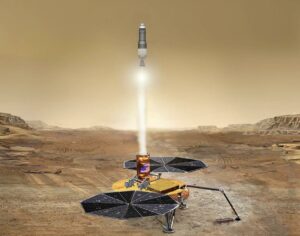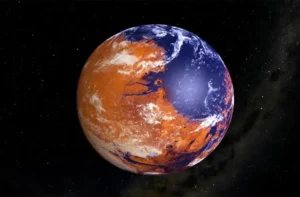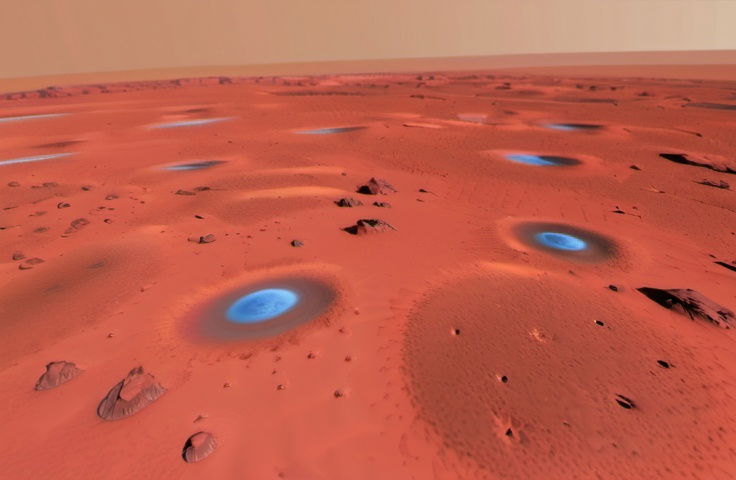A new study by Harvard scientists examining the mystery of water and life on ancient Mars has found several chemical mechanisms that likely contributed to a warmer, wetter environment capable of sustaining life.
Previous theories tried to explain how Mars could have sustained water on its surface long enough to support the evolution of life billions of years ago thanks to an abundance of hydrogen in the atmosphere. When hydrogen mixes with carbon dioxide, it can trigger more extended periods of greenhouse warming. Unfortunately, scientists still have difficulty explaining how hydrogen, which has a short lifetime, could have been continuously renewed in sufficient quantities.
Now, a research team from the Harvard John A. Paulson School of Engineering and Applied Sciences (SEAS) taking a fresh look at the mystery of water and life on ancient Mars believes they have identified the chemical mechanisms that could have enabled a warm, wet Mars for several prolonged periods.
They also suggest that bringing home samples collected by NASA’s Perseverance Rover on the much-maligned Mars Sample Return Mission, which has faced several false starts, rescheduling, redirections, and restarts, could offer material support for their conclusions as soon as the next decade.


“Early Mars is a lost world, but it can be reconstructed in great detail if we ask the right questions,” explained Robin Wordsworth, the Gordon McKay Professor of Environmental Science and Engineering at SEAS, in a statement. “This study synthesizes atmospheric chemistry and climate for the first time to make some striking new predictions – which are testable once we bring Mars rocks back to Earth.”
Modeling the Mystery of Water and Life on Ancient Mars
Although Mars technically orbits within the Sun’s habitable zone, where it receives sufficient radiation to support liquid water on its surface, the planet is currently almost entirely arid. Still, over the last three decades, several rovers, orbiters, and observatories have collected evidence pointing to ancient oceans, underground lakes, and hidden rivers on Mars. This disparity has left scientists with something of a mystery, particularly given the conditions in the solar system billions of years ago.
“It’s been such a puzzle that there was liquid water on Mars because Mars is further from the sun, and also, the sun was fainter early on,” said Danica Adams, NASA Sagan Postdoctoral Fellow and lead author of the paper outlining the team’s findings. Nonetheless, Adams acknowledged that overwhelming data supporting a warm, wet planet has challenged scientists to explain the mystery of water and life on ancient Mars.


Hoping to explain the discrepancy by building on previous studies proposing atmospheric hydrogen as a solution, Adams used photochemical modeling techniques similar to those used to track pollutants in Earth’s atmosphere. Specifically, the researcher employed a KINETICS model to simulate how hydrogen and other gases in the ancient Martian atmosphere interacted with the ground and the air. The resulting model revealed several compelling conditions supporting a persistent presence of hydrogen in the planet’s atmosphere.
For example, the models showed several episodic warm spells lasting “over about 40 million years” each during Mars’ Noachian and Hesperian periods, which lasted between 4 and 3 billion years ago. The models also showed how these warm, wet periods were driven by crustal hydration. According to the Harvard research team, when this process occurs, the Martian atmosphere is consistently replenished with enough raw hydrogen to support sustained warm periods lasting millions of years.
Notably, the researchers also modeled several other conditions on ancient Mars and presented those alternatives in the study. According to the researchers, those alterations include modeling the role CO and CO2 may have played in the shifting cold and warm periods on ancient Mars.
“We’ve identified time scales for all of these alternations,” Adams said. “And we’ve described all the pieces in the same photochemical model.”
Waiting for Mars Perseverance Rover Samples to Come Home
Although the new work is based on computer models, the Harvard research team says samples collected by the Mars Perseverance rover could allow them to test their theoretical isotopic ratios to those present in actual Mars rocks. The team also notes that the lack of plate tectonics on Mars has left the planet’s surface in much the same condition it was billions of years ago, allowing for a unique learning opportunity once they have those samples in hand.
“It makes a really great case study for how planets can evolve over time,” Adams said.
In the study’s conclusion, the researchers say their work can offer a new tool to help finally solve the mystery of water and life on ancient Mars. They also believe their findings could provide fresh insights into the conditions that may have supported prebiotic chemistry, “the underpinnings of later life as we know it,” during Mars’ varying warm and cold cycles.
The study “Episodic warm climates on early Mars primed by crustal hydration” was published in Nature Geoscience.
Christopher Plain is a Science Fiction and Fantasy novelist and Head Science Writer at The Debrief. Follow and connect with him on X, learn about his books at plainfiction.com, or email him directly at christopher@thedebrief.org.

